 |
||
|
||
| ||
from HIS (IceQ III Turbo) and Sapphire (Ultimate)
TABLE OF CONTENTSSeveral months have passed since the announcement of new RV670-series graphics cards, and these products start to fill the market. Having been launched on Christmas eve, the RADEON HD 38xx was very popular, of course. It affected its prices, and some stores price tagged these cards twice as much as the recommended value. The RADEON HD 3850 and 3870 are compromise products. These cards have the same core, they differ only in operating frequencies of GPU and memory. They are identical in other respects. The RADEON HD 2900 XT has a 512-bit memory bus, which makes the card much more expensive, but of little help to users. Huge memory bandwidth is good, but AA is executed by shader units, not ROPs, as it used to be. As a result, the huge and superexpensive bandwidth is not utilized completely, while the core suffocates executing shader commands and AA. So we can all see that instead of free AA (owing to the 512-bit bus), we get a performance drop, which is even greater than with the old 256-bit bus. That's an illustrative example of an unbalanced solution. That's why no matter how much the marketing department praised the HD 2800 XT, it left the market much earlier than deserves a product that had taken so much time and efforts to design. And AMD got another record into its collection of negative results, which is already full. The company launched a new GPU as a compromise - RV670. It also has 320 unified processors, the same number of texturing units as in the 2900 XT, but its controller was redesigned for the 256-bit memory bus. The number of its transistors has grown, but only because of optimizations and larger caches. Owing to the new fabrication process, manufacturing costs of the RV670 are much lower than those of the R600 (2900 XT). It allowed the company to offer relatively inexpensive graphics cards for $150 - $200 (we speak of recommended prices, the real retail prices are certainly higher because of the recent holidays and high popularity). AMD manufactured only the first batches of such cards on its own. Then all partners got an opportunity to buy GPUs instead of ready cards, so many partners launched graphics cards of different design and cooling systems. New resource-intensive games (especially CRYSIS) raised popularity of 512-MB graphics cards, because 256MB of video memory is apparently insufficient for CRYSIS. That's why many ATI/AMD partners, including HIS and Sapphire, launched the HD 3850 512MB, although this product was initially equipped with twice as little memory. A couple of such graphics cards will be reviewed today. Both cards are equipped with interesting coolers, and the HIS product also operates at increased frequencies.
Graphics Cards
As we have expected, these cards are of the reference design. I want to repeat that the HIS card is overclocked.
The cards have TV-Out with a unique jack. You will need a special bundled adapter to output video to a TV-set via S-Video or RCA. You can read about the TV-Out in more detail here. Analog monitors with d-Sub (VGA) interface are connected with special DVI-to-d-Sub adapters. The bundle also includes DVI-to-HDMI adapters (these graphics cards support video/audio transfer to HDMI receivers), so there should be no problems with such monitors. Maximum resolutions and frequencies:
What concerns MPEG2 playback features (DVD-Video), we analyzed this issue in 2002. Little has changed since that time. CPU load during video playback on modern graphics cards does not exceed 25%. HDTV and other trendy video features. You can read one review here. These cards require additional power supply, so they are bundled with an adapter from molex to 6-pin, even though all modern PSUs are equipped with these cables. Now about the cooling systems. What concerns the HIS product, it's equipped with the familiar cooler from Arctic Cooling, IceQ III. We've examined it many times, so you may read about this device in this article. In brief, it's the best, most efficient, and noiseless cooler of all we've ever seen. Its only drawback is that it takes up two slots on a motherboard. But this is not considered a problem these days. Sapphire took a different route. This card is called Ultimate for a reason. Yep, the graphics card is equipped with a passive cooling system, that is it has no fan. It's a very popular solution of late. Considering that the card operates at the standard frequencies, we knew even before tests that there would be no problems with overheating. The cooler has a massive heat sink on the back side of the PCB. However, it's raised quite high above the PCI-E connector, so there should be no problems with motherboards, which north bridge with the cooler are close to the PCI-E x16 slot. We monitored temperatures using RivaTuner (written by A.Nikolaychuk AKA Unwinder). Here are the results: HIS IceQ III RADEON HD 3850 Turbo 512MB PCI-E Sapphire HD 3850 Ultimate 512MB PCI-E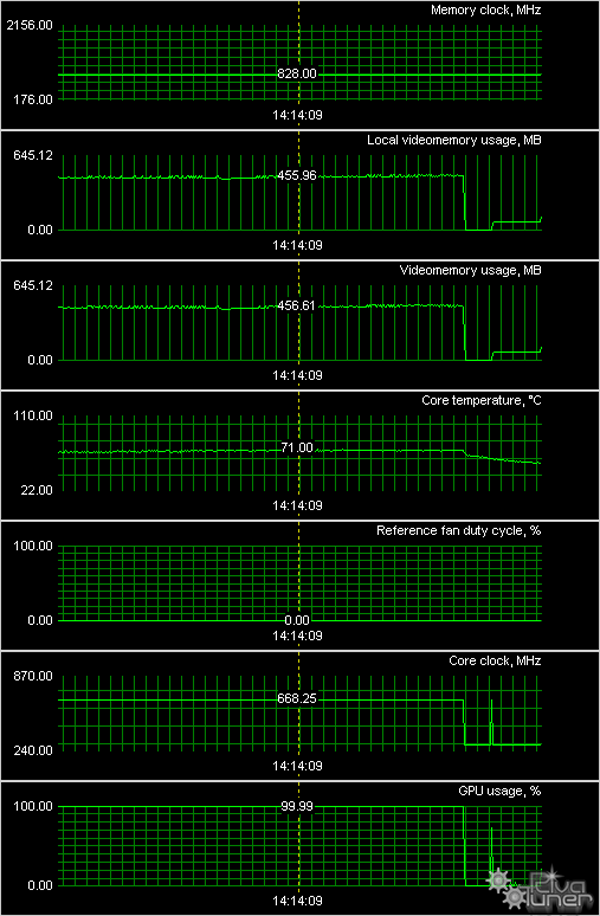 Operating temperatures of even the overclocked graphics card from HIS do not cross the limit, they remain below 72B°. The same results are demonstrated by the Sapphire card. It's another proof of the high efficiency of these cooling systems.
Bundle Packages
Installation and DriversTestbed configuration:
VSync is disabled.
Test results: performance comparisonWe used the following test applications:
Graphics cards' performance
If you have a decent understanding of 3D graphics, you may draw your own conclusions for the diagrams below. However, if you are interested in our comments on test results, you may read them after each test. Anything that is important to beginners and those who are new to the world of video cards will be explained in detail in the comments. First of all, you should look through our reference materials on modern graphics cards and their GPUs. Be sure to note the operating frequencies, support for modern technologies (shaders), as well as the pipeline architecture.
ATI RADEON X1300-1600-1800-1900 ReferenceNVIDIA GeForce 7300-7600-7800-7900 ReferenceIf you have just begun realizing how large the selection to choose a video card is, don't worry, our 3D Graphics section offers articles about 3D basics (you will still have to understand them - when you run a game and open its options, you'll see such notions as textures, lighting, etc) as well as reviews of new products. There are presently two companies that manufacture popular GPUs: AMD (its ATI department is responsible for graphics cards) and NVIDIA. We can also mention Matrox, S3. However, their share of the discrete graphics market is less than 1%, so we can discard them. So most of the information is divided into these two sections. We also publish monthly 3DSpeed that sums up all comparisons of graphics cards for various price segments. Thirdly, have a look at the test results of our today's cards. We are not going to analyze each test in this article, primarily because for us it makes sense to draw a bottom line in the end of the article. We will, however, make sure that we make our readers aware of any special circumstances or extraordinary results. S.T.A.L.K.E.R.
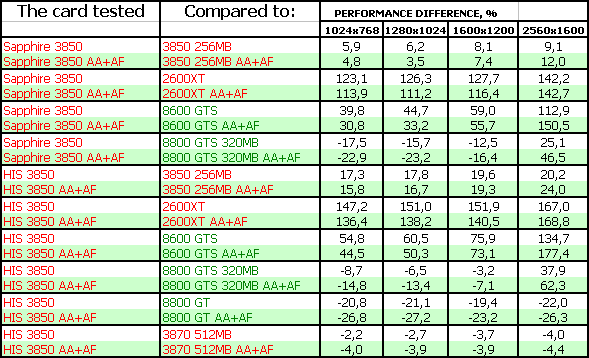
CRYSIS, Rescue, DX9, High
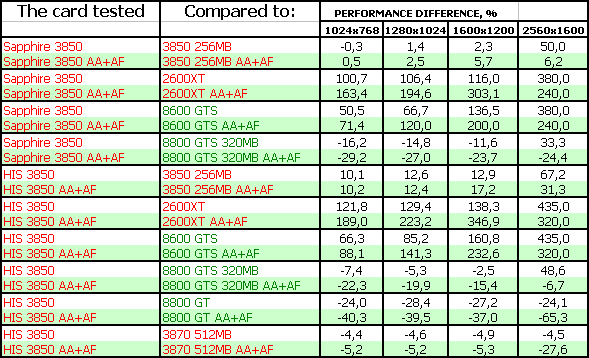
CRYSIS, Harbor, DX9, High

CRYSIS, Rescue, DX10, Very High

CRYSIS, Harbor, DX10, Very High

Call Of Juarez
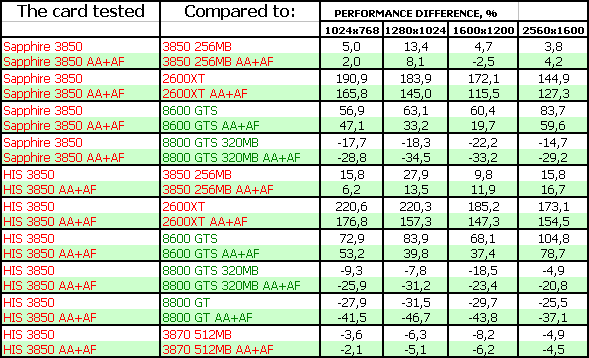
Company Of Heroes
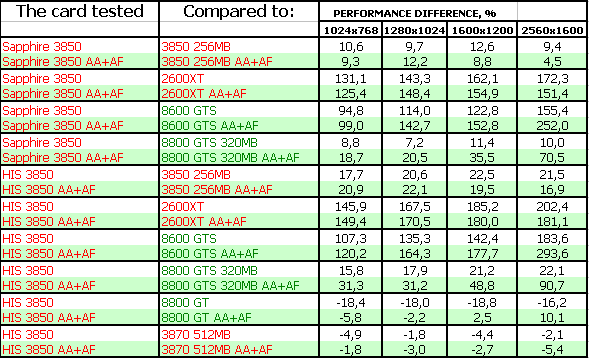
3DMark05: MARKS

3DMark06: SHADER 2.0 MARKS

3DMark06: SHADER 3.0 MARKS
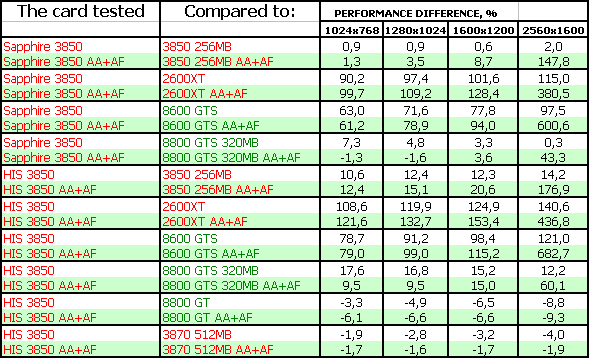
ConclusionsAccording to our tests, both cards profit much from 512MB of video memory in new games. Yep, we can say that 256MB of video memory is becoming a thing of the past. The entry level is going to be 512MB soon. We speak of Mid- and High-End graphics cards, of course. Low-End products won't benefit from much memory, because of their slow GPUs.
HIS IceQ III RADEON HD 3850 Turbo 512MB PCI-E is an excellent graphics card for its price! Its performance is close to that of the HD 3870, and it has a noiseless cooling system. Of course, it's slower than the GeForce 8800 GT, but their prices differ as well (at least, if we take recommended retail prices; price distortions are caused by deficit, so they will straighten up soon.) We should also mention the excellent bundle with the bonus.
Sapphire HD 3850 Ultimate 512MB PCI-E is also a very good product for its price. Its operating frequencies are not increased, but the cooler is very good, and its operating temperatures are not high. In other respects, all the above said holds true for this model as well. What concerns the bonus, the card ships with 3Dmark and DVD Suite. Some users may need them.
And now the general conclusion on the HD 38xx. We have some minor gripes with rendering quality in CRYSIS even with the latest drivers (7.12).
As always, the final choice is up to the reader. We can only inform you about products and their performance, but can't make a buying decision. In our opinion, that should solely be in the hands of the reader, and possibly their budget. ;) And here is one more thing, we'll repeat it in each review. Having decided to choose a graphics card on your own, you should be aware that you change one of the key components of your system unit, which may require additional configuration for better performance or you may have to enable some functions to achieve higher quality. This is not an end product, it's just a component. So you should understand that you'll have to learn 3D graphics basics in order to get maximum performance from a new graphics card. And some graphics in general. If you don't want to deal with it, you shouldn't upgrade your computer on your own: you'd better buy ready PCs with preconfigured software and technical support from your system integrator, or game boxes, where no configuration is required, everything necessary is already configured in a game. To find more information regarding the current graphics card market and the performance of various cards, feel free to read our monthly special 3DSpeed.
The following cards get our Original Design award (January): 
Our Excellent Package award (January) goes to: 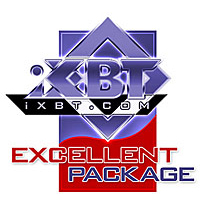
We express our thanks to
HIS Russia and Vitali Milov Sapphire Russia and Constantine Martynenko for the provided graphics cards
Write a comment below. No registration needed!
|
Platform · Video · Multimedia · Mobile · Other || About us & Privacy policy · Twitter · Facebook Copyright © Byrds Research & Publishing, Ltd., 1997–2011. All rights reserved. | ||||||||||||||||||||||||||||||||||||||||||||||||||||||||||